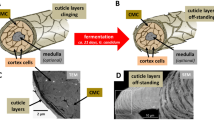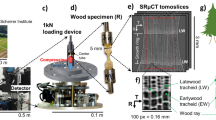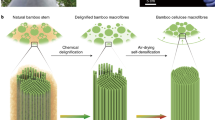Abstract
CHRYSOTILE asbestos, the major fibrous serpentine polymorph, occurs naturally as veins in massive serpentine. It has been established1,2 that chrysotile has a cylindrical crystal habit and occurs as fibrils 200 Å–400 Å in diameter. The orientation of the fibrils in the rock is such that the fibril axis is approximately perpendicular to the vein wall, forming a cross-fibre deposit, and the fibre length is frequently equal to the width of the rock vein; often the fibres grow from both walls and join at a central fissure or break. In commercial usage fibre length is an important characteristic, so various methods of length classification have been developed and applied to commercial raw material. These methods generally apply only to macro-fibre bundles, however, each of which contains a large number of parallel fibrils. No data have been published for the fibril lengths of chrysotile, although it is apparent from examination of electron micrographs of dispersed chrysotile fibrils that they exceed several tens of microns in length. This agrees with an aspect ratio of 5,000 derived from strength measurements by Wronski3. In addition, Aveston4 suggests that the somewhat broader fibrillar units of the amphibole asbestos crocidolite have lengths in excess of 1 mm. It is still uncertain, however, whether the lengths of individual chrysotile fibrils correspond to the length of the macro fibres or are shorter, because of defects introduced during growth or by subsequent geological faulting. This uncertainty limits the understanding and full utilization of the properties of chrysotile, in particular its mechanical properties.
This is a preview of subscription content, access via your institution
Access options
Subscribe to this journal
Receive 51 print issues and online access
$199.00 per year
only $3.90 per issue
Buy this article
- Purchase on Springer Link
- Instant access to full article PDF
Prices may be subject to local taxes which are calculated during checkout
Similar content being viewed by others
References
Whittaker, E. J. W., Acta Cryst., 10, 149 (1957).
Keiji, Y., Acta Cryst., 23, 704 (1967).
Wronski, J. P., Asbestos, 50 (2), 3 (1968).
Aveston, J., J. Mater. Sci., 4, 625 (1969).
Bobkowicz, A. J., and Gauvin, V. H., Chem. Eng. Sci., 22, 229 (1967).
Burgers, J. M., Second Report on Viscosity and Plasticity (Nordemann, New York, 1938).
Blakeney, W. J., J. Colloid Interface Sci., 22, 324 (1966).
Author information
Authors and Affiliations
Rights and permissions
About this article
Cite this article
ATKINSON, A., GETTINS, R. & RICKARDS, A. Estimation of Fibril Lengths in Chrysotile Asbestos Fibres. Nature 226, 937–938 (1970). https://doi.org/10.1038/226937a0
Received:
Issue Date:
DOI: https://doi.org/10.1038/226937a0
This article is cited by
-
Evaluation of Sensitivity of Fluorescence-Based Asbestos Detection by Correlative Microscopy
Journal of Fluorescence (2012)
-
Drag reduction in fibre suspension
Nature (1981)
Comments
By submitting a comment you agree to abide by our Terms and Community Guidelines. If you find something abusive or that does not comply with our terms or guidelines please flag it as inappropriate.



